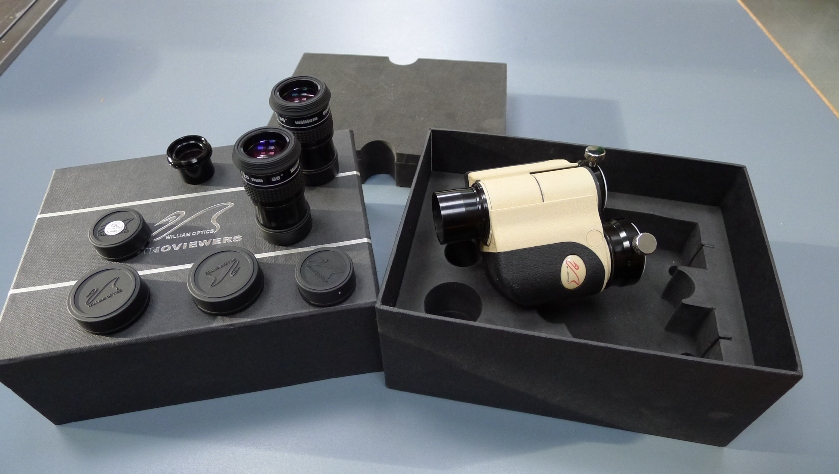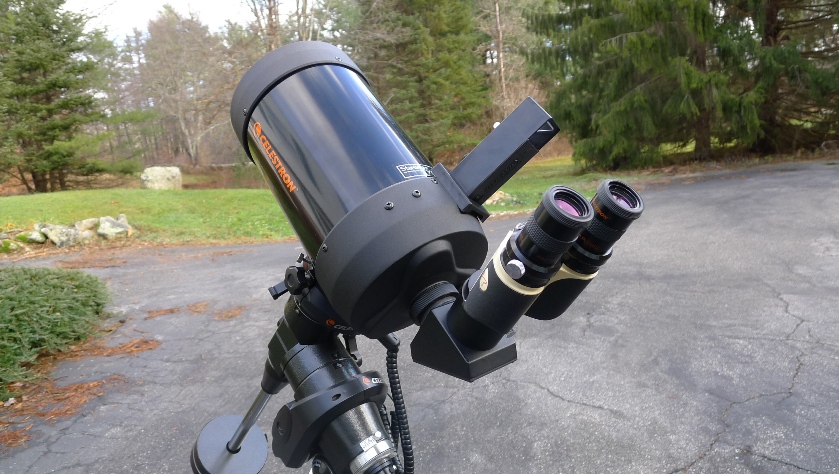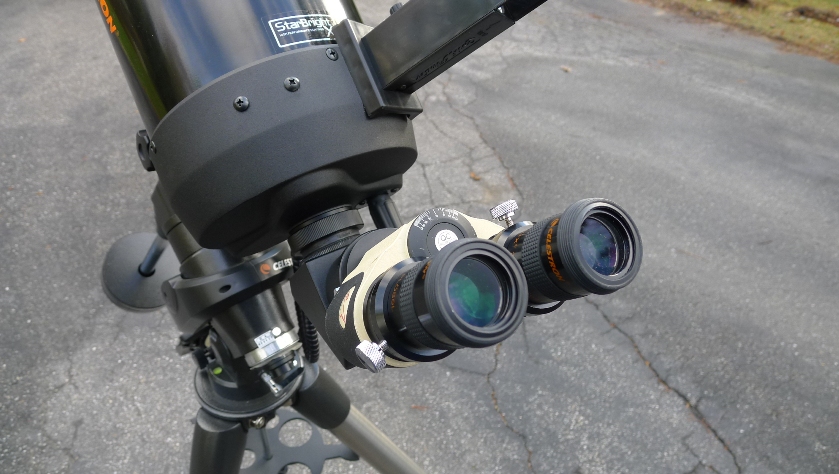(1.25" binoviewer, 1.6X multiplier, two 20 mm Plossl eyepieces, heavy duty box/carrying case, $225 - $250 street)
It sounds like a simple proposition. Split the image into two, put in a pair of your favorite eyepieces, and enjoy the freedom of viewing with two eyes. But as anyone who's done it will tell you, things aren't quite that simple. While binoviewing can yield tremendous rewards, there are many complications to getting there. Consider:
First, obviously, you are taking one image and splitting it into two, so you are not getting true binocular vision. Also, since each eye is seeing less than half the light of your scope's aperture, the image will be dimmed quite a bit.
Binoviewers take up a lot of focus travel - anywhere from 4.5" to almost 6" in some cases. Because of this, they will not find focus in many telescopes without the use of a barlow. Since the binoviewer tends to increase the magnification by itself (about 25% - 50% depending on your scope) you will find yourself boxed in to high powers and small fields of view.
Using medium to high powers creates a problem. As the power increases, people start to lose the ability to merge the images in their eye/brain systems. This ability varies among people; I find that I can successfully "marry" images up to 125X or so. Beyond that point, I see two images side by side. Also, if you wear glasses, this seems to complicate the "merging" issue for some observers.
Because of the above, binoviewing often becomes a never-ending chase to obtain lower and lower powers. There is a thriving aftermarket of barlows with "weak" multiplication. The current winner in the low power sweepstakes is the remarkable 1.2X unit by Siebert. While it works as advertised, the barlow is quite long and will cut off the light from some scopes. It is also long enough that you risk hitting the secondary in some small reflectors. So the unit will allow you to "back off" at the expense of image brightness. And since binoviewing dims your view to begin with, this is the last thing you want.
If you have a Schmidt-Cassegrain, you are in luck. Most SCTs have enough focus travel to accommodate a binoviewer without any barlow at all. However, because of the added focus travel, the binoviewer seems to add 25% - 50% power on its own, even without a barlow. The amount of magnification boost varies depending on which SCT you have. Since SCTs tend to have longish focal lengths to begin with, you are often back in the same boat - boxed in to medium and high powers. One solution to this is to get a small SCT. I keep a C5 around just for this purpose. Its focal length of 1250 mm is reasonable and I can easily fit the full moon into the field of view with a pair of 25 mm or 32 mm Plossls.
The binoviewer will add weight to the back of your scope. A lot of weight. From a weight perspective, a C5 effectively becomes a C6. A C6 becomes the weight of a C8. And a C8 starts to strain your average CG-5 with a binoviewer attached. The overhanging load of the mechanical contraption at the back of your scope is always in danger of flopping over. Don't laugh; it's happened to everyone at least once. Having the binoviewer break loose always results in the eyepieces dangling upside down. If they aren't secured, they will fall out and hit the pavement. Many of you cup your hands underneath the binoviewer while the scope is slewing in case this happens (a particularly dangerous moment when using an SCT). I consider myself quite careful, and yet, two months ago, my inattentiveness resulted in a friend's 19 mm Panoptic getting dropped on my driveway. I hope none of you have to experience that awful sound of glass hitting asphalt.
As a result of the above, if you use a binoviewer on an SCT, I strongly urge the use of a thread-on diagonal. You have a limited product choice when it comes to these SCT diagonals, but they are much more secure and eliminate at least one mechanical connection. If you have the money for the Baader unit - which has a built-in diagonal - more power to you.
On a reflector, the binoviewer will add weight to the front of the scope. If you have an equatorial reflector with rings, you can just slide the tube back. If you have a Dobsonian, you are going to have balance issues. Plan on adding weight to the back of the tube.
On a refractor, you face similar issues as the SCT. Weight gets added to the back of the scope, which swings around in a wide arc as you move it around. Make sure your bolts, screws, etc are tightened down.

The WO binoviewer package - a lot of nice equipment for ~$250
After reading the above, you may be wondering - why bother at all? Well...if you've ever looked through a properly set up binoviewing rig, you know why. The views can be simply stunning. Remember your wonder and fascination when you first looked at the moon through a telescope? Get ready to experience that feeling again. Looking with two eyes seems to relax the brain and body, and you want to linger on the object. This holds true for planets and (if you can get it to work on your scope) on deep sky objects as well. Everything seems to take on a 3-D look and it can be hard to tear yourself away from the view. For a real treat, point your scope at the moon, turn off the drives, and watch the moon drift across the field of view. You'll feel like you're flying across the surface.

William Optics binoviewer on the Celestron C6. Note thread-on diagonal.
Much has changed since my last binoview article back in 2000. Back then, binoviewing was a fringe activity done by wealthy observers. Today binoviewers are an enthusiastic, vocal bunch, and exert influence on observers and manufacturers alike (recently, TeleVue shaved 1 mm off the diameter of its 13 mm Ethos so that more observers could use them in binoviewers.)
Roughly speaking, binoviewers fall into two classes: those costing about $1000, and those costing about $200 ("middle class" products such as the original Denkmeier and the Burgess attempt to bridge the gap with models costing about $500.) In the past, if you owned a $200 binoviewer, it meant one thing - some poor microscope sacrificed its head for an astronomer. Microscope head-based units were easily recognizable from their 45 degree erect-image prisms and .965" eyepieces (and, sadly, by their often poor performance.) Today things have changed. There is no shame in owning a $200 binoviewer. While they have smaller prisms and reduced clear apertures as a result, within those bounds they perform perfectly well and allow more astronomers to experience the thrill of binoview observing.
No one's talking, but the WO unit appears to be very similar to $200 binoviewers sold by Celestron and Orion. I selected the WO because of its intriguing 1.6X barlow. This is much a lower powered multiplier than any other I'd seen. Most other units are sold with a 2X barlow. I showed the ad to local club member John P, who is the club's de facto bino view expert (John owns a TeleVue and a Denk II, along with a duffel bag full of binoview accessories.) He expressed doubt, smiling and shaking his head at the same time. Lower powered binoview barlows tend to be longer, not shorter (the WO 1.6X barlow is the stubbiest, shortest barlow I've ever seen.) Still, I figured that even if the barlow didn't work as advertised, the unit was still a bargain.
The William Optics binoviewer arrived in a nice, sturdy cardboard case. Taking the unit out, I was impressed by its hefty build quality. The binoviewer comes with a pair of 20 mm "Swan" eyepieces with a claimed 66 degree field of view. The barlow was perhaps the only disappointment - it's small and seems way too light.
I was fortunate to have a variety of scopes at hand for testing the binoviewer. I tried the unit in the C90, C5, C6, C8, a Starmaster Oak Classic, and Orion Short Tube 80, a Pronto, a Takahashi FS-60CSV, and 12.5" and 20" Obsessions. After playing musical chairs with the equipment for months, I found the C5, C6, and the Oak Classic were the bet fit. On the Starmaster, I had to move the mirror all the way up to find focus. And when all was said and done, I found myself using the binoviewer on the C6 over 90% of the time.
But enough of all this. You don't care about any of the above, do you? What you want to know is this - does a typical $200 binoviewer give you the same experience as the more expensive units?
The answer, I'm afraid, is no.
Having said that, a $200 binoviewer with sensible 20 mm or 25 mm Plossls will knock your socks off while viewing the moon. At one local skywatch, a club member said the view of the moon through the WO/C5/CG-5 combination was the best he'd ever seen. You may also get decent views of Jupiter and Saturn, provided you don't push the power too high. Deep sky is tough. With the smaller prisms, you lose a lot of light. I never did get the binoviewer to find focus in the 12.5" Obsession, either with or without the supplied 1.6 X multiplier. It didn't work in the Oak Classic either. All of this started me wondering what the purpose of the barlow was. I'm thinking it's just to boost the power, not to help you find focus. However, as stated above, boosting the power is the last thing you want in a binoviewer. In the end, I wound up putting the 1.6X barlow away and haven't used it since.
You can play games with your own barlows. I tried slipping my TeleVue 1.8X, 2X, 2.5X, and Meade 3X barlows over the nosepiece to see what would happen. In the 12.5" Obsession, only the 2X would find focus, and only if I moved the mirror up all the way. Unfortunately, moving the mirror up meant that I could no longer find focus with my eyepieces. Since the views through the WO/2X combination weren't anything to write home about, I stopped using it this way and moved the mirror back to its original position.

Even cheap eyepieces like the Celestron 25 mm E-Lux work well.
One of the most expensive parts of any binoviewer are the internal prisms. When manufacturers start to cut corners on any binoviewers, the first thing that happens is the prisms start to shrink. The same holds true for binoculars - cheap binoculars have much smaller prisms inside. This is hard to evaluate unless you hold the binoculars up to the light to see the exit pupils. In a nice pair of binoculars, exit pupils are nice and round. Cheaper binos will have squared off exit pupils.
The result of the shrunken prisms is that the clear apertures of the binoviewers also shrink. Top quality binoviewers like the Denk II and the TeleVue have massive prisms inside, yielding nice big 26 mm or 27 mm clear apertures. Cheap binoviewers have a considerably smaller spec - 20.2 mm in the case of these WOs. Does this matter? Absolutely. First, the difference between 20 mm and 27 mm is huge - over half a magnitude. The nice binoviewers are going to throw out a noticeably brighter image. Just as importantly, the smaller 20 mm clear aperture is going to limit the kinds of eyepieces you can use - most significantly, the big low-power eyepieces you were planning on using. Most 32 mm Plossls, for example, have about a 25 mm clear aperture. Not only will the image be dimmer, you may see vignetting around the edges. Ever wonder why cheap binoviewers are always sold with a pair of 20 mm eyepieces? They're not being nice to you, they're hoping you don't go experimenting too much. I've looked through many pairs of eyepieces with the WO, and have come up with a partial list of what works:
TeleVue 32 mm Plossls: Light cutoff, but barely noticeable on bright objects on the moon. You need a binoviewer with at least 25 mm clear aperture for these to perform at their best.
TeleVue 25 mm Plossls: Excellent. The best all-around eyepieces. I'd start my collection with these.
TeleVue 20 mm Plossls: Very good also. Short eye relief. Power starting to get high on longer focal length scopes like the C8 (or bigger)
Most generic 32 mm, 25 mm, 20 mm Plossls. Very good also. The Orion Sirius line seems popular for observers on a budget, and the eyepieces work well.
Orion 15 mm Expanses: Good for wide field observing on a budget.
TeleVue 24 mm Panoptics: Superb low power eyepieces. Eye relief is on the short side. Pricey.
TeleVue 19 mm Panoptics: Excellent, but expensive compared to the 20 mm Plossls, which gives similar results (I find wide field eyepieces to be less effective on binoviewers) Short eye relief.
TeleVue 12 mm and 14 mm Radians: These work very well. I suspect the other Radians also work well. A little on the heavy side, so be sure and tighten those set screws!
TeleVue 13 mm Nagler Type 6: Very nice for close up sweeping views on the moon. Short eye relief.
TeleVue 16 mm Nagler Type 6: Similar to the 13 NT6, above.
Again, if you have a full-sized binoviewer like the TeleVue, Denk II, or Baader, you can use any eyepieces you want without fear of vignetting. I don't have the money to buy two 13 mm Ethos eyepieces, but those who have tried them tell me the view is stunning.
The William Optics binoviewer is excellent value for the money and gives a taste of that binoview glory for a fraction of the cost of the expensive units. On the other hand, if you are truly dedicated to binoview observing, you really do need one of the nicer units. The TeleVue and Baader are self-contained "set it and forget it" products - there isn't much to modify. If you're a tinkerer, you might be happier with a Denkmeier. Seeing all their combinations of nosepieces, multipliers, and various accessories in various configurations makes my head hurt, but Denk owners are more than happy to experiment.
Binoviewing has become a regular part of my observing now. I use the binoviewer about 25% of the time. If you haven't used one before, check one out. You may find that you just have to get one.
End Various Reviews Page 11
Back to Home Page